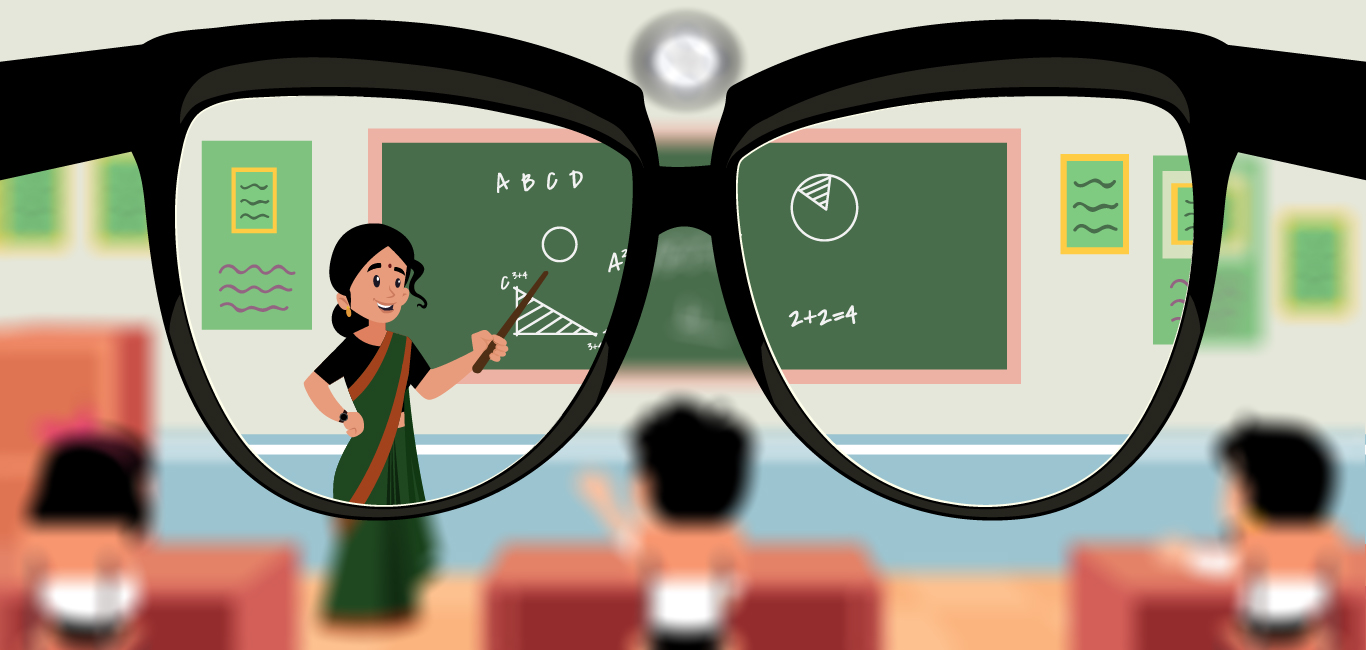
Does your child frequently squint or tilt their head to see distant objects or complain about headaches? Do they regularly hold their favourite books and digital devices too close to their face? As parents, we should check out these signs of myopia or short-sightedness in the kids.
Myopia is a common vision problem that usually begins in childhood. While the near-sighted kids can see up close but far away and across the room appear blurry to them.
“It is the most common refractive error and a significant cause of eye and vision problems, especially in school-going children and young adults,” says Dr Sreekanth P Namboothiri, MS (Ayurveda), chief medical officer at Sreedhareeyam Ayurvedic Eye Hospital and Research Center, Koothattukulam Kerala.
An extended smartphone use may increase the likelihood of eye problems, including myopia, eye fatigue and dry eyes, especially in children. Dr Namboothiri cautions, “As the world is progressing fast, in the current scenario use of smartphones and screens is inevitable. It is our duty to use them wisely.”
“Kids rarely complain of near-sightedness—either because they are unaware of a problem or afraid of having their devices taken away. So early detection is always a challenge,” says Dr Ayana Raj, Adichunchanagiri Ayurvedic Medical College and Research Centre.
Genetic predisposition, environmental factors associated with urbanization, increased digital work, and lack of time spent outdoors are all considered to be myopia’s risk factors. When they act together the risk increases.
A higher prevalence of myopia has been observed in urban populations compared to rural populations, Says Dr Namboothiri.
A study published in the American Academy of Ophthalmology says that 22.9 % of the world population was affected with myopia in 2000, and its estimated that almost 50% will have myopia by 2050.
Parental involvement in prevention
There are holistic options to manage myopia; these include eye exercises and specialized eye treatments. However, myopia cannot be cured in adults using these. However, diagnosing and managing myopia starting at an early age can undoubtedly help.
Current myopia management protocols are limited to corneal reshaping methods, atropine drops, and multifocal lenses. But there are a host of other options currently being explored. And a new focus on holistic management of myopia in children, especially if it is discovered early, is getting a lot of attention.
Parents need to limit screen time and encourage their kids to play outdoors, says Dr Namboothiri. Research shows that up to two hours of outside play each day may have a protective effect against the onset of myopia, even for those with high amounts of digital work.
“I strictly follow the “20-20″ rule with my kid. Every 20 minutes on an electronic device, I will ask them to focus their gaze on objects 20 feet away for a break of 20 seconds,” says Chandini Reddy, mother of a seven-year-old child from Bengaluru.
The World Health Organization’s new guidelines recommend no screen time for infants under the age of one year, and no more than two hours a day for kids aged 2-4.
Dr Sreekanth added that adequate rest for the eyes is always advised. The natural light and fresh scenery can help keep the eyesight sharp.
Ayurvedic therapy of myopia
Ayurveda follows a Brimhana or nourishing line of treatment by strengthening the ocular muscle and the power of accommodation. The treatment may vary from person to person depending on their Prakriti or the unique body constitution and the dosha vitiation (imbalance in the energy level).
ALSO READ: Vata, Pitta and Kapha: Ayurveda’s three vital entities explained
A judicious combination of oral medicines, ayurvedic eye therapies, Pratimarsha nasya (nasal medication), and eye exercise are advised to manage myopia in children.
Some of the ayurvedic eye therapies advised for myopia are aschothanam (herbal eye drop), anjanam (herbal eye ointment), netra dhara (herbal eye wash), tarpanam (rejuvenating eye therapy), thalapodhichil (wrapping the head in a special herbal paste) and drishti prasadhana kriya (special massage on the 23 marma (vital areas) points around the head).
As per Dr Namboothiri, ayurvedic treatment is found to be more effective up to the age of 20 years. If it is simple myopia and the spherical power is less than two dioptres, it can be brought down, in most cases, to almost normal power.
Role of nutrition in myopia
A healthy, balanced diet is essential to maintain one’s health, and eye health is no different.
When it comes to foods to avoid, Dr Namboothiri recommends avoiding junk food that is low in nutritional value and unsuitable for eye health.
In terms of what you should consider eating for good eye health, ayurvedic practitioners recommend foods like shastika (red rice), barley, green gram, pomegranates, gooseberry, ghee, and goats’ milk for better eye health. Consume green leafy vegetables, especially drumstick leaves, and drink plenty of water.
Certain nutrients are key to avoiding eye health-related problems: Studies show that children with myopia have lower levels of proteins, fat, vitamins B1, B2, and C, phosphorus, and iron than children without myopia.
Experts recommend foods rich in vitamins A, C, and E; coloured fruits, carrots, papaya, and green leafy vegetables in one’s diet. These foods not only delay myopia progression, but some of the essential nutrients – lutein, zeaxanthin, and zinc – prevent the onset of chronic eye conditions. Vitamins A, C, and E help make healthy retinal cells suitable for better sight and vision.
Role of eye exercise in myopia
Eye exercises can help reduce strain. When genetic factors and not visual fatigue cause myopia, eye exercise will not be completely effective. But they can help to slow down the effects of myopia over time. Eye exercises can help strengthen your eyes and improve coordination and focus better. It helps to reduce eyestrain and sensitivity to light. Some exercises for managing myopia are bouncing the balls, breathing exercises, palming, shifting focus and alternate eye movement.
However, if your eye doctor has prescribed you spectacles, then it is best advised to wear them all the time, to avoid worsening your condition.

















